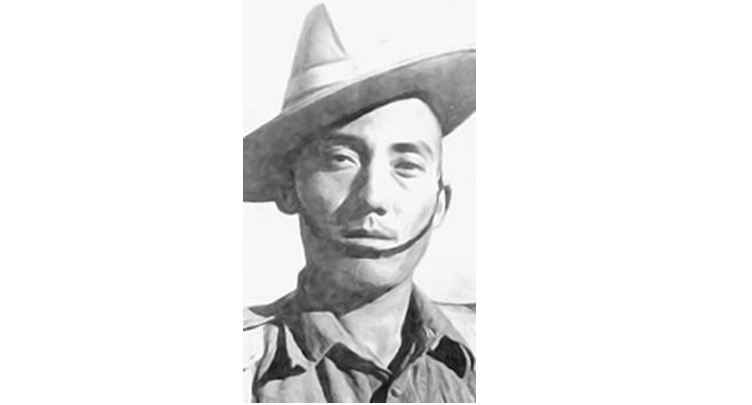Naik Agansing Rai
Naik Agansing Rai (24 April 1920 – 27 May 2000) was a Nepalese Gurkha recipient of the Victoria Cross, the highest and most prestigious award for gallantry in the face of the enemy that can be awarded to British and Commonwealth forces. He was born in the village of Amsara, in the Okhaldhunga district of Nepal.
In April 1941, he enlisted in the Gurkhas, and two years later was promoted to section commander with the rank of Naik, a rank equivalent to Corporal. Agansing Rai was a 24 year old Naik in the 2nd Battalion, 5th Royal Gurkha Rifles, 17th Indian Division during World War II, when he led his section in an attack on one of two posts which had been taken by the enemy and were threatening the British forces’ communications on 26 June 1944 near the town of Bishenpur in the state of Manipur, India.
The Japanese Army was on the offensive in March 1944, its goal was to capture India, but first it had to fight with the 14th Army in Central Burma under General William Slim. The Japanese under General Muraguchi attacked with formidable ferocity and the British IV Corps, based on Imphal and Kohima, bore the brunt of the attack. Three of its divisions were besieged, including the 17th Indian, the so called “black cat” Division. IV Corps had just 50,000 men against 90,000 Japanese, But the British and US Air forces controlled the skies and the Japanese had no supply routes, so they had to strike quickly. They were determined to take Imphal, but the Black Cats defended their position heroically, and during the ferocious engagement Rai won his VC.
“In Burma on 24th and 25th June, 1944, after fierce fighting, the enemy, with greatly superior forces, had captured two posts known as ‘Water Piquet’ and ‘Mortar Bluff’. These posts were well sighted and mutually supporting and their possession by the enemy threatened our communications. On the morning of 26th June, 1944 a company of the 5th Royal Gurkha Rifles (Frontier Force) was ordered to recapture these positions.
After a preliminary artillery concentration, the company went in to attack but on reaching a false crest about 80 yards from its objective, it was pinned down by heavy and accurate fire from a machine gun in ‘Mortar Bluff’ and a 37 millimeter gun in the Jungle, suffering many casualties. Naik Agansing Rai , appreciating that more delay would inevitably result in heavier casualties, at once led his section under withering fire directly at the machine gun and, firing as he went, charged the position, himself killing three of the crew of four. Inspired by this cool act of bravery the section surged forward across the bullet-swept ground and routed the garrison of ‘Mortar Bluff’.
This position was now under intense fire from the 37-millimeter gun in the jungle and from ‘Water Piquet’. Naik Agansing Rai at once advanced towards the gun, his section without hesitation following their gallant leader. Intense fire reduced the section into three men before half the distance had been covered. But they pressed on their objective. Arriving at close range, Naik Agansing Rai killed three of the crew and his men killed the other two. The party then returned to ‘Mortar Bluff’ where the rest of the platoon were forming for the final assault on ‘Water Piquet’. In the subsequent advance, heavy machine gun fire and showers of grenades from an isolated bunker position caused further casualties. Once more with indomitable courage, Naik Agansing Rai, covered by his Bren gunner, advanced alone with a grenade in one hand and his Thompson Sub-Machine gun in the other. Through devastating fire he reached the enemy position and with his grenade and bursts from his Thompson Sub-Machine gun killed all four occupants of the bunker.
The enemy demoralized by this NCO’s calm display of courage and complete contempt for danger, now fled before the onslaught on ‘Water Piquet’ and this position too were captured. Naik Agansing Rai’s magnificent display of initiative, outstanding bravery and gallant leadership, so inspired the rest of the Company that, inspite of heavy casualties, the result of this important action was never in doubt.”
(The London Gazette, 5 October 1944)
Soon the Japanese were in a fighting retreat amid the monsoon. Their Campaign had been a disaster and 65,000 of their men died through combat, starvation and disease. Plans to invade India were abandoned.
Rai received his VC from the Viceroy, Field Marshal Lord Wavell, in 1945. He was subsequently promoted to company commander with the rank of Subedar; and after Indian independence, he joined the Indian Army and was promoted to Havildar. He retired in 1971 with the honorary rank of Captain and died in Kathmandu on May 27, 2000, at the age of eighty.





